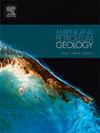Insights into the wetting mechanisms in low-permeability sandstone reservoirs and its evolution processes: The shahejie formation in the Dongying Depression, Bohai Bay basin
IF 3.7
2区 地球科学
Q1 GEOSCIENCES, MULTIDISCIPLINARY
引用次数: 0
Abstract
During the accumulation and development processes of low-permeability oil, wettability plays a crucial role in the percolation capacity of fluids. In particular, the evolution of low-permeability sandstones involves complex changes in formation fluid properties and mineral types, leading to a deficient understanding of wetting mechanisms in low-permeability sandstones. This gap significantly impedes research on the accumulation mechanisms of low-permeability oil. Focusing on the low-permeability sandstones in Shahejie formation of Dongying Depression, Bohai Bay Basin, tests like Casting thin section, scanning electron microscope, contact angle measurement, molecular dynamics simulation and the Amott method based on nuclear magnetic resonance technology were performed to comprehensively investigate sandstone wettability and its evolutionary process. The results indicate that the adsorption capacity of hydroxyl groups or monovalent cations (K+and Na+) for water molecules causes residual intergranular pores, feldspar dissolution pores, quartz dissolution pores, clay mineral intercrystalline pores and micro-cracks to exhibit hydrophilicity; while the adsorption capacity of divalent cations (Ca2+and Mg2+) for oil molecules causes the surface of dissolution pores of carbonate minerals to exhibit neutrality or lipophilicity. Additionally, changes in formation conditions (temperature, pressure, ion types, and ion concentration) significantly control the wettability of pore surfaces, further determining the overall wettability of low-permeability sandstone reservoirs. Throughout the evolutionary process of low-permeability sandstones, the Amott-Harvey index of low permeability sandstone is greater than zero, and the wettability exhibited hydrophilic or neutral. From A-stage eodiagenesis to B-stage mesodiagenesis, the Amott-Harvey index is 0.82, 0.12, 0.37, 0.03, and 0.49, and the wettability of reservoirs transitions through phases of strong hydrophilicity, weak hydrophilicity, hydrophilicity, neutrality, and hydrophilicity, respectively. Finally, an evolutionary model of the wettability of low-permeability sandstone reservoirs was established, which is of great significance for predicting the quality of low-permeability sandstone reservoirs.
对低渗透砂岩储层润湿机制及其演化过程的认识渤海湾盆地东营凹陷沙河街地层
在低渗透石油的积累和开发过程中,润湿性对流体的渗透能力起着至关重要的作用。特别是,低渗透砂岩的演化涉及地层流体性质和矿物类型的复杂变化,导致人们对低渗透砂岩的润湿机制认识不足。这一空白极大地阻碍了对低渗透石油累积机制的研究。以渤海湾盆地东营凹陷沙河街地层低渗透砂岩为研究对象,通过铸造薄片、扫描电子显微镜、接触角测量、分子动力学模拟和基于核磁共振技术的阿莫特法等试验,对砂岩润湿性及其演化过程进行了全面研究。结果表明,羟基或一价阳离子(K+和Na+)对水分子的吸附能力使残留晶间孔、长石溶孔、石英溶孔、粘土矿物晶间孔和微裂缝表现出亲水性;而二价阳离子(Ca2+和Mg2+)对油分子的吸附能力使碳酸盐矿物溶孔表面表现出中性或亲脂性。此外,地层条件(温度、压力、离子类型和离子浓度)的变化在很大程度上控制着孔隙表面的润湿性,进一步决定了低渗透砂岩储层的整体润湿性。在低渗透砂岩的整个演化过程中,低渗透砂岩的阿莫特-哈维指数大于零,润湿性呈现亲水性或中性。从A阶段eodiagenesis到B阶段mesodiagenesis,Amott-Harvey指数分别为0.82、0.12、0.37、0.03和0.49,储层的润湿性分别经历了强亲水、弱亲水、亲水、中性和亲水等阶段。最后,建立了低渗透砂岩储层润湿性的演化模型,这对预测低渗透砂岩储层的质量具有重要意义。
本文章由计算机程序翻译,如有差异,请以英文原文为准。
求助全文
约1分钟内获得全文
求助全文
来源期刊

Marine and Petroleum Geology
地学-地球科学综合
CiteScore
8.80
自引率
14.30%
发文量
475
审稿时长
63 days
期刊介绍:
Marine and Petroleum Geology is the pre-eminent international forum for the exchange of multidisciplinary concepts, interpretations and techniques for all concerned with marine and petroleum geology in industry, government and academia. Rapid bimonthly publication allows early communications of papers or short communications to the geoscience community.
Marine and Petroleum Geology is essential reading for geologists, geophysicists and explorationists in industry, government and academia working in the following areas: marine geology; basin analysis and evaluation; organic geochemistry; reserve/resource estimation; seismic stratigraphy; thermal models of basic evolution; sedimentary geology; continental margins; geophysical interpretation; structural geology/tectonics; formation evaluation techniques; well logging.
 求助内容:
求助内容: 应助结果提醒方式:
应助结果提醒方式:


